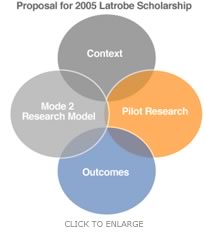

06/2005
Latrobe Fellowship awarded to Chong Partners and research team
by Heather Livingston
In 2003, the San Diego chapter of the AIA founded the Academy of Neuroscience as its legacy project to research how the human brain perceives and responds to architecture. The College of Fellows supported the enterprise by awarding the academy its Latrobe Fellowship, which comes with a purse of $100,000. To build on that body of research, the College on May 20 awarded the 2005 Latrobe Fellowship jointly to Chong Partners Architecture, the Kaiser Foundation Health Plan Inc., and the University of California, Berkeley. The funds will support their endeavor to record “credible, applicable evidence” that proves the hypothesis that “the right design would increase revenue and reduce costs due to shorter length of stay, improved patient outcomes, staff retention, and other variables” in health-care facilities.
 Explaining the project’s impetus, Gordon Chong, FAIA, principal
of Chong Partners said, “While the AIA and the profession have
pursued various research venues, it has never become part of the profession’s
culture. As architecture becomes a more complex and knowledge-based profession,
clients will begin looking for more intuitive, experiential, evidence-based
design. Clients are under tremendous scrutiny and restraints to make
good decisions. They need to know, ‘Is the design decision relevant
and making a significant impact on sales, students, productivity, etc.?’”
Explaining the project’s impetus, Gordon Chong, FAIA, principal
of Chong Partners said, “While the AIA and the profession have
pursued various research venues, it has never become part of the profession’s
culture. As architecture becomes a more complex and knowledge-based profession,
clients will begin looking for more intuitive, experiential, evidence-based
design. Clients are under tremendous scrutiny and restraints to make
good decisions. They need to know, ‘Is the design decision relevant
and making a significant impact on sales, students, productivity, etc.?’”
Chong believes that this research has the potential to change the manner in which practitioners think and will enhance their ability to answer these questions. It will start with architect’s current skills and layer onto them evidence-based design that is more predictive about human responses to spaces and designs. “It adds science to the art to make it more relevant,” he says.
Going beyond intuition
Larry Leis, FAIA, 2005 chancellor of the College of Fellows, echoed Chong’s
comments, “As architects we know intuitively how design functions
in creating a healing environment, but we don’t have the research
to back it up. As [Academy of Neuroscience Founding President] John Eberhard
says, ‘It needs to go beyond intuition.’”
Leis also points out that for many years lack of research has spurred debate about whether architecture is a “learned profession.” This research could lead architecture toward becoming a more preeminent profession, he believes. It also will place a higher value on the architect’s services, he says, because architects will have the research and tools at their disposal to make evidence-based design decisions.
In the pilot project, Chong Partners, Kaiser, and UC-Berkeley will use psychological, sociological, and physiological measures to investigate how diverse groups of patients and staff respond to specific design characteristics. The goal of the research is “to create results that are defensible under the scrutiny of client decision makers, professionals, and academic peers.” The proposal also states that, “[the results] must directly inform design decisions. Architects need to know what to build—informed by empirical data, not conjecture—and be able to support their assertions about design impacts in order to garner client approval to implement design innovations.”
Chong considers the integrated process “one of the most important characteristics of the research.” Kaiser will provide the setting and access to patients and staff. UC-Berkeley will provide rigor for how the research is undertaken and will examine physiological as well as behavioral responses. Chong Partners will supply the design itself as well as a PhD staff person who will evaluate the physiological evidence.
Far-reaching results
Although the primary result will be evidence-based design criteria for
a new hospital environment, the partners believe that the research
model itself will be a critical outcome. “By piloting use of
the model, including assessing and refining it during the process,
the team will develop an understanding of how architectural impacts
can be effectively understood and communicated,” Chong says. “We
are committed to developing a model that is applicable and transferable.
The methodologies that develop evidence-based design should establish
predictive human responses and be transferable across the entire profession.”
“I commend the leadership of the College of Fellows for their vision in seeing the link between research and practice and understanding how research can add value to the profession as a whole,” says Chong. “I also offer my congratulations to all fellows for their support of the Latrobe Fellowship, which is, in my opinion, the most significant research grant in the profession.”
Copyright 2005 The American Institute of Architects.
All rights reserved. Home Page ![]()
![]()
 |
||
The Benjamin Henry Latrobe Fellowship is awarded biennially by the College of Fellows for research leading to significant advances in the architecture profession. This year’s recipient was selected from 30 projects submitted from the U.S., Mexico, Canada, and India. The preliminary jury met in March to select the final candidates and was composed of the College of Fellows Executive Committee: Lawrence J. Leis, FAIA, chancellor; Ted P. Pappas, FAIA, vice chancellor; Carole J. Olshavsky, FAIA, bursar; Frank E. Lucas, FAIA, secretary; and Jack Hartray, FAIA who attended in place of Jury Chair Marvin Malecha, FAIA). This jury selected four finalists for review. The final jury met in April at the Princeton, N.J., offices of Michael Graves, FAIA, and included Graves, Malecha, Hartray, Leis, and John Zeisel, PhD.
|
||